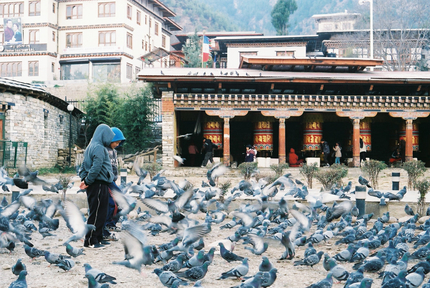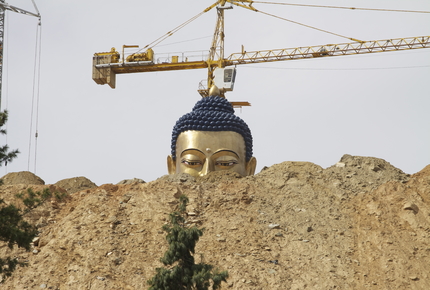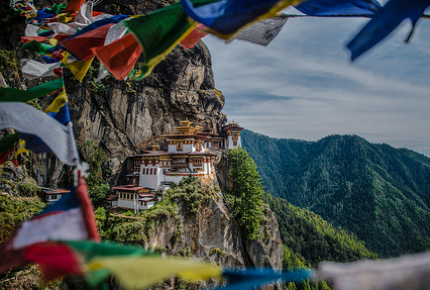Bhutan or bust: Selling Shangri-la at a premium
Is the world's most expensive visa fee a way for tourists to pay for Bhutan's road to riches? Or is Bhutan truly the last Shangri-la? Kara Fox investigates.
At first glance, Bhutan is just that – a magical landscape seemingly immune to the pull of the ever-tightening grip of modernity. Situated at a dizzying 2235 meters above sea level, most journeys begin with a steep descent into Bhutan’s sole international airport. The adventurous flight in can feel as reason enough to want to visit – a mix of altitude, excitement and vibrant green rice paddies growing in the shadow of imposing Himalayan snow-capped peaks will create a pungent cocktail of sensory overload for even the most experienced traveller. The Bhutanese word namasame literally translates as ‘between the heavens and the Earth’ – and landing in Paro town can feel that’s exactly where you’ve arrived.
Like all foreigners, my experience in Bhutan began by being greeted at the airport and whisked away to Paro town, a world of white washed houses, quaint roadside vegetable vendors and tidy, winding roads.
A few months earlier I had been offered a job working at a luxury resort in Paro town. Securing a working visa allowed me to avoid paying the mandatory $250 per day visa costs, which clips most travellers’ trips to about a week or two maximum. The luxury of this ‘free time’ allowed me to form more lasting friendships, to learn Dzongkha, the national language, and to adapt my taste buds to the national dish, ema datse – a diet of never ending chillies and cheese. But most importantly, it allowed me to gain a more coloured perspective into the friendly debate between tourism's model Buddhist pleasantries and the Bhutanese internalization of those ideas.
When I arrived I rapidly began to notice the discrepancy between what I had thought existed as a land untouched by modernity in this ‘Shangri-La’ versus its reality. Tour guides sporting Oakley sunglasses walked around the town in traditional ghos (a large man-skirt of sorts), complimented by knee high socks. Old women spinning prayer wheels in one hand could be seen typing on their iPads in the other. Monks on mobiles, DJs at discos spinning top 40 tracks, everyone under 30 obsessed with social media. Was this so foreign after all?
 A market square in the city of Thimphu, Bhutan
A market square in the city of Thimphu, BhutanCreative Commons/Xiaojun Deng
Maybe I was unfairly spotting obvious physical juxtapositions, especially in today’s globalised world. But in a place that markets development and tourism with an official policy of Gross National Happiness over Gross National Product it seems blissfully ignorant to experience Bhutan only for what the tourism council encourages you to see.
In order to understand Bhutan’s current connection to a world ‘long gone’ and its marketed nostalgia, we should look to its past.
As Bhutan’s neighbours, China and India embarked on its development journey during the 1950’s they began to offer its citizens some of the benefits of development such as education, transport and healthcare services. In comparison, Bhutan was being rapidly left behind in providing social welfare for its people. This created the desire amongst leaders, specifically the 4th King, to kick-start Bhutanese development in the early 1960s – concentrating on basic infrastructure such as schools, hospitals and roads, seen as vital for creating a social safety net. Bhutan, however, was starting from a very different place than its bigger neighbours. At the time, the manufacturing sector was seen as the best point of entry in to the world’s economy for developing nations, a sector Bhutan was unlikely to succeed in due to its small, disparate and under-educated population, matched with no roads and little electricity. Uniquely, leaders also stressed the importance of maintaining religious piety whilst managing these developmental changes. This inevitably led to some difficult questions: how to fund such expensive projects when you have none of the means, or desire to mimic development orthodoxy?
Desperately needing to earn foreign exchange, development planners quickly identified their cultural heritage as their most lucrative asset and set about creating a ‘Buddhist inspired’ platform that still characterises its tourist industry. By unabashedly targeting ‘quality’ tourism, the Kingdom’s autocratic rulers hoped to both raise revenue whilst preserving cultural integrity, creating a vision of ‘sustainable tourism’ decades before that buzzword was first coined.
As such, the ‘Land that Time Forgot’ opened its doors to its first international tourists in 1974. Numbers were kept to a minimum and the stress on cultural learning. Visa costs were set at prohibitively high levels to discourage all but the most committed (and affluent) traveller while maximising revenue for the burgeoning social programs. Except for a few small details, the platform has remained unchanged since. Although numbers are no longer limited, the $250 per day visa fee effectively acts as a barrier to most and independent travel is still shunned in favour of Government approved tours.
The first paved road completed in 1962 shaved 6 days off the travel time between capital city Thimphu and the Indian border, increasing not just the flow of new goods but also ideas. 1999 saw the arrival of cable television and internet, which increased the speed of developmental progress in ways which are still yet to be fully understood. Luxury hotels and spas are luring more and more tourists in every year; upward social mobility and financial credit is on the rise.
 The Buddha Dordenma statue under construction back in 2010
The Buddha Dordenma statue under construction back in 2010Creative Commons/Zachary Collier
Like all best laid plans there have been unforeseen consequences. Bhutanese youth have experienced changes, which would have been unimaginable to their grandparents. History tells us that with travel and trade come new ways to interpret the world we live in and how to find a place within it. 16th century European explorers didn’t just bring back exotic goods from the new worlds, but also regaled stories of the mythical lands that laid the foundation of the West’s imagination of the ‘Other’ ever since. Likewise, Bhutan’s captured tourism market has effectively done the same internally.
So, what does this look like for travel to the Kingdom? On one hand the official narrative of the nation remains unchanged; a traditional, isolated and remote Himalayan country that might appear poor to outsiders, but thanks to its strong sense of tradition has riches that cannot be put in monetary terms. On the other hand, the steady flow of alternative ideas be it TV shows, music, or blue denim jeans are having profound effects on the ideas of place and identity within a new generation of Bhutanese that are struggling to find a space within which to express themselves – both internally and to its tourists.
So in this country that is seeing tourism growing annually, we might want to look a bit deeper into the true cost of Bhutan's development. Is the Himalayan Kingdom just trying a little too hard to live up to its own brand for the tourists? Or is it really a Shangri-La, now paved by the riches of its believers?
 Paro Taktsang, the Tiger's Nest Monastery
Paro Taktsang, the Tiger's Nest MonasteryS Jakkarin/Thinkstock
Do you have any Feedback about this page?
© 2025 Columbus Travel Media Ltd. All rights reserved. No part of this site may be reproduced without our written permission, click here for information on Columbus Content Solutions.









 You know where
You know where